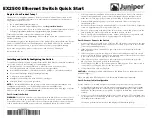
DLDP Fundamentals
213
Table 142
DLDP packet types
DLDP packet type
Function
Advertisement
Notifies the neighbor devices of the existence of the local device. An
advertisement packet carries only the local port information, and it
does not require response from the peer end.
RSY-Advertisement
packets (referred to as
RSY packets hereafter)
Advertisement packet with the RSY flag set to 1. RSY advertisement
packets are sent to request synchronizing the neighbor information
when neighbor information is not locally available or a neighbor
information entry ages out.
Flush-Advertisement
packets (referred to as
flush packets hereafter)
Advertisement packet with the flush flag set to 1. A flush packet
carries only the local port information (instead of the neighbor
information) and is used to trigger neighbors to remove the
information about the local device.
Probe
Probe packets are used to probe the existence of a neighbor. Echo
packets are required from the corresponding neighbor. Probe
packets carry the local port information. Neighbor information is
optional for probe packets. A probe packet carrying neighbor
information probes the specified neighbors; A probe packet carrying
no neighbor information probes all the neighbors.
Echo
Response to probe packets. An echo packet carries the information
about the response port and the neighbor information it maintains.
Upon receiving an echo packet, a port checks whether the neighbor
information carried in the echo packet is consistent with that of
itself. If yes, the link between the local port and the neighbor is
regarded as bidirectional.
Disable
Disable packets are used to notify the peer end that the local end is
in the disable state. Disable packets carry only the local port
information instead of the neighbor information. When a port
detects a unidirectional link and enters the disable state, the port
sends disable packets to the neighbor. A port enters the disable
state upon receiving a disable packet.
LinkDown
Linkdown packets are used to notify unidirectional link emergencies
(a unidirectional link emergency occurs when the local port is down
and the peer port is up). Linkdown packets carry only the local port
information instead of the neighbor information. In some
conditions, a port is considered to be physically down if the link
connecting to the port is physically abnormal (for example, the Rx
line of the fiber on the port is disconnected, while the Tx line
operates properly). But for the peer end, as Rx signals can still be
received on the physical layer, the port is still considered to be
normal. Such a situation is known as unidirectional link emergency.
When a unidirectional link emergency occurs, DLDP sends linkdown
packets immediately to inform the peer of the link abnormality.
Without linkdown packets, the peer can detect the link abnormality
only after a period when the corresponding neighbor information
maintained on the neighbor device ages out, which is three times
the advertisement interval. Upon receiving a linkdown packet, if the
peer end operates in the enhanced mode, it enters the disable state,
and sets the receiving port to the DLDP down state (auto shutdown
mode) or gives an alarm to the user (manual shutdown mode).
Recover Probe
Recover probe packets are used to detect whether a link recovers to
implement the port auto-recovery mechanism. Recover probe
packets carry only the local port information instead of the neighbor
information. They request for recover echo packets as the response.
A port in the DLDP down state sends a recover probe packet every
two seconds.
Содержание Switch 7754
Страница 32: ...32 CHAPTER 1 CLI OVERVIEW ...
Страница 70: ...70 CHAPTER 5 LOGGING IN USING MODEM ...
Страница 76: ...76 CHAPTER 7 LOGGING IN THROUGH NMS ...
Страница 86: ...86 CHAPTER 9 CONFIGURATION FILE MANAGEMENT ...
Страница 120: ...120 CHAPTER 13 ISOLATE USER VLAN CONFIGURATION ...
Страница 126: ...126 CHAPTER 14 SUPER VLAN ...
Страница 136: ...136 CHAPTER 16 IP PERFORMANCE CONFIGURATION ...
Страница 152: ...152 CHAPTER 17 IPX CONFIGURATION ...
Страница 164: ...164 CHAPTER 19 QINQ CONFIGURATION ...
Страница 172: ...172 CHAPTER 21 SHARED VLAN CONFIGURATION ...
Страница 182: ...182 CHAPTER 22 PORT BASIC CONFIGURATION ...
Страница 198: ...198 CHAPTER 24 PORT ISOLATION CONFIGURATION ...
Страница 208: ...208 CHAPTER 25 PORT SECURITY CONFIGURATION ...
Страница 224: ...224 CHAPTER 27 DLDP CONFIGURATION ...
Страница 232: ...232 CHAPTER 28 MAC ADDRESS TABLE MANAGEMENT ...
Страница 240: ...240 CHAPTER 29 CENTRALIZED MAC ADDRESS AUTHENTICATION CONFIGURATION ...
Страница 280: ...280 CHAPTER 30 MSTP CONFIGURATION ...
Страница 348: ...348 CHAPTER 35 IS IS CONFIGURATION ...
Страница 408: ...408 CHAPTER 39 802 1X CONFIGURATION ...
Страница 412: ...412 CHAPTER 40 HABP CONFIGURATION ...
Страница 422: ...422 CHAPTER 41 MULTICAST OVERVIEW ...
Страница 426: ...426 CHAPTER 42 GMRP CONFIGURATION ...
Страница 480: ...480 CHAPTER 47 PIM CONFIGURATION ...
Страница 506: ...506 CHAPTER 48 MSDP CONFIGURATION ...
Страница 552: ...552 CHAPTER 51 TRAFFIC ACCOUNTING CONFIGURATION ...
Страница 570: ...570 CHAPTER 53 HA CONFIGURATION ...
Страница 582: ...582 CHAPTER 54 ARP CONFIGURATION SwitchA arp protective down recover interval 200 ...
Страница 622: ...622 CHAPTER 58 DHCP RELAY AGENT CONFIGURATION ...
Страница 684: ...684 CHAPTER 61 QOS CONFIGURATION ...
Страница 718: ...718 CHAPTER 63 CLUSTER ...
Страница 738: ...738 CHAPTER 67 UDP HELPER CONFIGURATION ...
Страница 752: ...752 CHAPTER 69 RMON CONFIGURATION ...
Страница 772: ...772 CHAPTER 70 NTP CONFIGURATION ...
Страница 796: ...796 CHAPTER 72 FILE SYSTEM MANAGEMENT ...
Страница 802: ...802 CHAPTER 73 BIMS CONFIGURATION ...
Страница 814: ...814 CHAPTER 74 FTP AND TFTP CONFIGURATION ...
Страница 830: ...830 CHAPTER 75 INFORMATION CENTER ...
Страница 836: ...836 CHAPTER 76 DNS CONFIGURATION ...
Страница 852: ...852 CHAPTER 77 BOOTROM AND HOST SOFTWARE LOADING ...
Страница 858: ...858 CHAPTER 78 BASIC SYSTEM CONFIGURATION DEBUGGING ...
















































